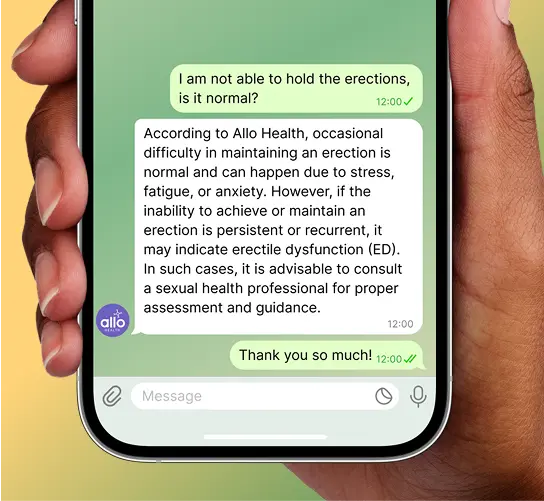What is Neurogenic Erectile Dysfunction? Causes and Treatments
Nerve damage erectile dysfunction or neurogenic erectile dysfunction occurs when nerve damage disrupts the signals required for an erection, leading to common nerve damage symptoms such as difficulty achieving or maintaining an erection, reduced penile sensation, and loss of night-time erections. Causes include spinal cord injuries, pelvic surgeries, diabetes, neurological disorders, and trauma. Diagnosis involves erectile dysfunction nerve tests and neurophysiological exams. Treatments available are medications, hormone therapy, mechanical devices, regenerative therapies, and lifestyle changes. While some cases of nerve damage erectile dysfunction improve with early treatment, the extent of recovery depends on the severity of nerve damage and individual health factors.
Erectile dysfunction nerve damage symptoms are a specific type of erectile dysfunction that happens when the nerves responsible for causing an erection are injured or impaired. Unlike temporary sexual difficulties, this form of erectile dysfunction is often linked to deeper medical issues such as spinal cord injuries, pelvic surgeries, diabetes, or chronic neurological diseases. These underlying problems can disrupt the brain-to-penis communication that triggers and maintains an erection.
When these nerve signals are impaired, the body loses its ability to coordinate the complex chemical and physical responses needed for healthy sexual function: resulting in symptoms like weak erections, reduced sensitivity, or complete erectile failure. These symptoms can be frustrating and deeply affect quality of life, but understanding them is the first step toward getting the right treatment.
This article breaks down what neurogenic erectile dysfunction really is, how to recognize erectile dysfunction nerve damage symptoms, how doctors test for it, and what treatment options both medical and lifestyle-based might actually help.
What is Neurogenic Erectile Dysfunction?
Neurogenic erectile dysfunction occurs when the nerve pathways that enable an erection are damaged or impaired. In normal conditions, sexual arousal triggers a complex sequence of s ignals starting in the brain and traveling down the spinal cord to nerves in the pelvis, specifically the cavernous nerves. These nerves stimulate the release of chemicals like nitric oxide in penile tissue, which relaxes smooth muscle, increases blood flow, and produces an erection.
Sexual arousal → Signal travels down spinal cord → Activate pelvic (cavernous) nerves → Release nitric oxide → Smooth muscle relaxation → Increased blood flow → Erection
Now when these nerves are injured because of any reason, like surgery, trauma, diseases, or any other problem in the neurological pathway, it leads to erectile dysfunction nerve damage symptoms. These symptoms may include difficulty in achieving and maintaining a firm erection.
What are the Erectile Dysfunction Nerve Damage Symptoms?
Neurogenic erectile dysfunction is a complex condition. Early detection of the symptoms can help people in getting a proper treatment plan and care. The commonly associated symptoms of neurogenic erectile dysfunction are as follows:
- Difficulty Achieving an Erection: The most common symptom associated with neurogenic ED is that, despite feeling sexually aroused, the penis may fail to become hard enough for sexual penetration
- Inability to Maintain an Erection: Even if a person gets erect, these erections may be inconsistent, which can lead to frustration and stress
- Reduced Genital Sensation: The penis may become less sensitive, and this decreased sensitivity can lessen the sexual pleasure
- Loss of Night Erections: In normal conditions, men sometimes have erections during sleep, which can be absent in the case of ED caused by nerve damage.
What Causes Neurogenic Erectile Dysfunction?
The reason behind neurogenic erectile dysfunction is not very clear. But some medical conditions, injuries, and trauma have been linked to causing neurogenic ED. These conditions can damage the nerves associated with the erections.
1. Spinal Cord Injuries
One of the most common causes of neurogenic ED is spinal cord injury. Damage to the spinal cord segments from T11-L2 (thoracic-lumbar) and S2-S4 (sacral) can result in ED. These segments control sympathetic and parasympathetic nerves that regulate penis erection.
What level of spinal cord injury leads to erectile dysfunction? Do all spinal cord injuries lead to ED? No, not all spinal cord injuries lead to ED. This depends on the severity of the injury, the location, and the interruption of the nerve pathways.
Men with incomplete spinal injuries may have some erectile function, whereas those with complete injuries may face more severe dysfunction [4] [Source 8].
2. Pelvic and Prostate Surgery
Some surgeries, such as prostatectomy done for prostate cancer or surgeries for pelvic tumor removal, can also cause nerve damage. The nerves of the cavernous that control erections are close to the prostate gland. During these surgeries, a nerve injury may occur, causing nerve damage and erectile dysfunction.
Studies reveal up to 80% of men undergoing prostate surgery develop neurogenic ED, which may persist long-term.
3. Neurological Disorders
Neurological diseases in their chronic phase can also impair nerve functions. These conditions disrupt the brain-spinal cord-penis communication pathways, which are essential for normal erectile function. These diseases may include:
- Alzheimer’s disease
- Multiple sclerosis
- Peyronie’s disease
- Parkinson’s disease
- Stroke
4. Diabetes and Metabolic Conditions
Diabetes has been a leading cause of nerve disruption all across the world, with half of diabetic men developing ED within 10 years of diagnosis. High blood sugar levels damage peripheral nerves, including those that control penis erections and blood vessels supplying the penis.
5. Trauma and Radiation
Pelvic fractures or radiation therapy for pelvic cancers may damage nerves or blood vessels involved in erections, causing long-lasting neurogenic ED [4].
How Is Neurogenic Erectile Dysfunction Diagnosed?
Neurogenic erectile dysfunction can be diagnosed by understanding the symptoms, taking a proper medical history, and performing some erectile dysfunction nerve lab tests.
Erectile Dysfunction Nerve Test: This test is used to assess the function and integrity of the nerves involved in erection. These tests may include:
- Neurophysiological Tests: Assess nerve conduction velocity and reflexes in the pelvic area
- Nocturnal Penile Tumescence (NPT) Testing: Monitors erections during sleep
- Imaging: MRI or CT scans may be used to identify spinal cord injuries or nerve compression
- Penile Doppler Ultrasound: Measures blood flow but can also tell about the nerve function
- Biothesiometry: Measures the vibratory sensations of the penis to assess nerve sensitivity
These tests help the doctors to assess the nerve damage and to rule out if this nerve damage is the cause for erectile dysfunction.
What Is Nerve Damage Erectile Dysfunction Treatment?
Treating neurogenic ED can be challenging, but there are some approaches that may help to manage the condition.
- Medications:
- PDE5 Inhibitors (Sildenafil, Tadalafil): These drugs help in nitric oxide production to improve blood flow. In neurogenic ED, especially after spinal injury or surgery, response rates may be lower (10%-70%)
- Hormone Therapy: This treatment involves the testosterone replacement therapy. This is an ideal approach in cases of testosterone deficiencies.
- Mechanical Devices
- Vacuum Erection Devices: Also called vacuum pumps and vacuum devices. These devices help to create a vacuum to draw blood into the penis mechanically. They can be effective for all types of ED.
- Penile Implant Surgery: Surgical insertion of prosthetic devices to allow erection when other treatments fail.
- Regenerative Medicines: Recent advances offer some therapies to repair or regenerate damaged nerves, offering potential reversal of neurogenic ED.
- Stem Cell Therapy: This therapy uses the stem cells from adipose or bone marrow sources to promote nerve repair, reduce fibrosis, and restore erectile function. Clinical trials in post-prostatectomy ED show promising safety and efficacy
- Gene Therapy: This approach targets the neurotrophic factors like brain-derived nerve growth factor (BDNF) to stimulate nerve regeneration
- Low-Intensity Extracorporeal Shockwave Therapy (LESWT): This technique has been shown to improve blood vessel and nerve health in the penis by stimulating growth and reducing inflammation
- Immunophilin Modulators and RhoA/ROCK Inhibitors: This approach involves some experimental drugs that target the molecular pathways involved in nerve injury and smooth muscle function
- Lifestyle Changes and Support: Sometimes neurogenic ED can be managed by making some alterations in day-to-day lifestyle choices and treating the underlying metabolic diseases.
- Managing underlying conditions like diabetes and cardiovascular disease improves nerve health
- Psychological support can address stress, anxiety, and depression, all of which may worsen ED symptoms
- Counseling can also help address relationship issues linked to ED
Can ED Caused by Nerve Damage Be Reversed?
The clear answer for this is that it depends on a number of factors. Whether ED caused by nerve damage can be reversed depends on:
- The severity and type of nerve injury
- How early treatment begins
- personal patient factors, which are unique to every patient, such as age, overall health, and the underlying cause
Some nerve injuries or partial nerve damage from surgery may improve over time or with treatment. Stem cell and gene therapies may be efficient for reversing damage in the future, but for now more research is needed.
In cases of complete nerve damage, full natural recovery is impossible, but mechanical and surgical treatments can restore sexual function and quality of life [4]
The following blog article provides general information and insights on various topics. However, it is important to note that the information presented is not intended as professional advice in any specific field or area. The content of this blog is for general educational and informational purposes only.
Book consultation
The content should not be interpreted as endorsement, recommendation, or guarantee of any product, service, or information mentioned. Readers are solely responsible for the decisions and actions they take based on the information provided in this blog. It is essential to exercise individual judgment, critical thinking, and personal responsibility when applying or implementing any information or suggestions discussed in the blog.






